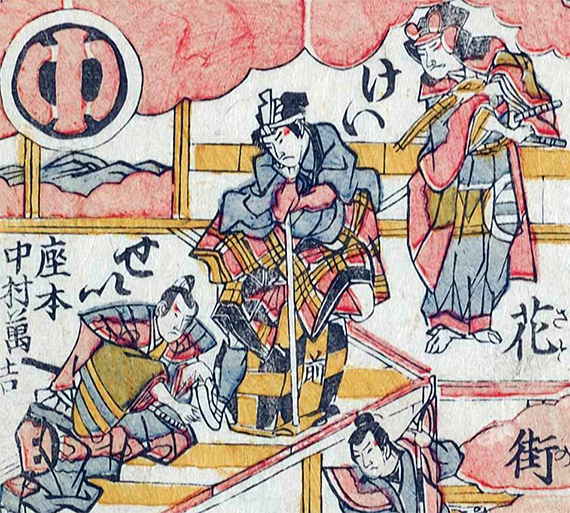| MIMASU MITSUGORď |
|
Stage names:
Guild: Kanaya [2] Nicknames: Miyakawa-ch˘; S˘daish˘ no Goinkyo Poetry name: Gyoyű Existence: ??? ~ 1835 [3] Connection: Masters: Arashi Sangor˘ II, Mimasu Daigor˘ I Elder brother: Mimasu Tokujir˘ I Disciple: Mimasu Kanjűr˘ Career: 1771: younger brother of Mimasu Tokujir˘ I, he started his career as an iroko in Ky˘to. His master Mimasu Daigor˘ I gave him the name of Mimasu Jirokichi. 1776: he became wakaonnagata. 11th lunar month of 1777: he became zamoto and produced in Ky˘to at the Minamigawa no Shibai the kaomise drama "Yunzei Nanshi no Sakigake", in which he played the roles of the keisei Hitachi (in reality Princess Tamagyu) and Miyamaru's sister Ohatsu. 25th day of the 9th lunar month of 1780 [4]: his first master Mimasu Daigor˘ I died. 1st lunar month of 1781: Jirokichi's rank in the Ky˘to hy˘banki, wakaonnagata section, was j˘-(shiro)j˘ (superior - (white) superior) [visual]. 1784: he became tachiyaku and took the name of Mimasu Mitsuz˘. 1st lunar month of 1786: Mitsuz˘ was recorded as performing in ďsaka at the Zama Shrine (miyaji shibai); his rank in the Kamigata hy˘banki, tachiyaku section, was j˘-j˘-(hanshiro)kichi (superior - superior - (half-white) excellent) [visual]. 1786 or 1787: he became disciple of Arashi Sangor˘ II and received the name of Arashi Mitsugor˘ I [1]. 1798: he took the name of Mimasu Mitsugor˘ in ďsaka at the Kadomaru no Shibai. 1st lunar month of 1801: Mitsugor˘ was recorded as performing in Ky˘to at the Kitano Shita-no-Mori Shibai; his rank in the Kamigata hy˘banki, tachiyaku/katakiyaku/jitsuaku section, was j˘-j˘-kichi (superior - superior - excellent) [visual]. 1st lunar month of 1803: Mitsugor˘ was recorded as performing in ďsaka at the Takeda no Shibai [5]; his rank in the Kamigata hy˘banki, tachiyaku section, was j˘-j˘-kichi (superior - superior - excellent) [visual]. 1st lunar month of 1803: Mitsugor˘ was recorded as performing in Ky˘to at the Inaba Yakushi (miyaji shibai); his rank in the Kamigata hy˘banki, tachiyaku section, was j˘-j˘-kichi (superior - superior - excellent) [visual]. 2nd day of the 5th lunar month of 1803 [6]: his second master Arashi Raishi I died in Ky˘to. 8th lunar month of 1807: Mitsugor˘ played at the Kadomaru no Shibai the leading roles of Ch˘emon and H˘kaib˘ in the dramas "Katsuragawa Renri no Shigarami" and "Sumidagawa Gonichi no Omokage". 26th day of the 8th lunar month of 1812 [7]: his elder brother Mimasu Tokujir˘ I died. Spring 1816: Mitsugor˘ performed at the Kadomaru no Shibai in the drama "Keisei Sato no Kawazu"; he shared the stage with Kataoka Ichiz˘ I. 1825: Mitsugor˘ worked as a zagashira at the Inaba Yakushi (miyaji shibai). 5th lunar month of 1831: Mitsugor˘ played at the Kita-Horie Ichi-no-Gawa Shibai (ďsaka) the leading roles of ďboshi Yuranosuke and Oginoya Yaegiri in the dramas "Kanadehon Chűshingura" and "Komochi Yamanba". 1835 [3]: Mitsugor˘ most likely died. Comments: Mimasu Mitsugor˘ was a popular and talented Ky˘to actor, who won fame for himself not in ˘shibai but in hama shibai in ďsaka or in miyaji shibai in Kamigata. He was equally at home in jidaimono or sewamono dramas, and was able to perform a wide range of roles, either male or female, and excelled in shosagoto and bud˘goto. He was a successful zagashira who had two nicknames:
[1] There were two Arashi Mitsugor˘ I in ďsaka at the same time but the ideograms used for the first name were different (check the table below). The other Arashi Mitsugor˘ I was not recorded in Nojima Jusabur˘'s book "Kabuki Jinmei Jiten".
You need a Japanese Language Kit installed within your system in order to be able to read the characters [2] Kanaya or Kaneya. Correct reading to be confirmed. [3] He was said to be the actor Asao Mitsugor˘ who died in 1838. [4] The 25th day of the 9th lunar month of the 9th year of the An'ei era was the 22nd of October 1780 in the western calendar. [5] More precisely, the Higashi Takeda no Shibai. [6] The 2nd day of the 5th lunar month of the 3rd year of the Ky˘wa era was the 20th of June 1803 in the western calendar. [7] The 26th day of the 8th lunar month of the 9th year of the Bunka era was the 1st of October 1812 in the western calendar. |
 |
|
Mimasu Mitsugor˘ (center) performing in the drama "Keisei Sato no Kawazu", which was staged in Spring 1816 at the Kadomaru no Shibai |
|
|
| Contact | Main | Top | Updates | Actors | Plays | Playwrights | Programs | Links | FAQ | Glossary | Chronology | Illustrations | Prints | Characters | Derivatives | Theaters | Coming soon | News |